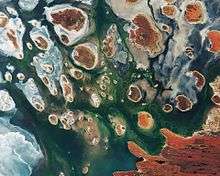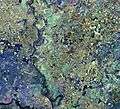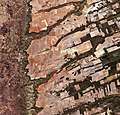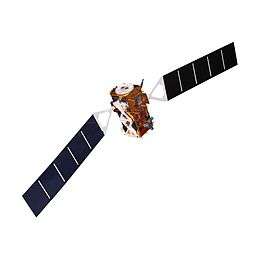Sentinel-2
Sentinel-2 is an Earth observation mission from the Copernicus Programme that systematically acquires optical imagery at high spatial resolution (10 m to 60 m) over land and coastal waters. The mission is a constellation with two twin satellites, Sentinel-2A and Sentinel-2B.
.jpg) Model of a Sentinel 2 satellite | |||
| Manufacturer | |||
|---|---|---|---|
| Operator | European Space Agency | ||
| Applications | Land and sea monitoring, natural disasters mapping, sea ice observations, ships detection | ||
| Specifications | |||
| Spacecraft type | Satellite | ||
| Bus | AstroBus-L | ||
| Constellation | 2 | ||
| Design life | 7 years | ||
| Launch mass | 1,140 kg (2,513 lb)[2] | ||
| Dry mass | 1,016 kg (2,240 lb)[2] | ||
| Dimensions | 3.4 × 1.8 × 2.35 m (11.2 × 5.9 × 7.7 ft)[2] | ||
| Power | 1,700 W[3] | ||
| Production | |||
| Status | Active | ||
| Built | 2 | ||
| Launched | 2 | ||
| Operational | 2 | ||
| Maiden launch | Sentinel-2A 23 June 2015 | ||
| Last launch | Sentinel-2B 7 March 2017 | ||
| |||
The mission supports a broad range of services and applications such as agricultural monitoring, emergencies management, land cover classification or water quality.
Sentinel-2 has been developed and is being operated by ESA, and the satellites were manufactured by a consortium led by Airbus DS.
Overview
The Sentinel-2 mission has the following key characteristics:
- Multi-spectral data with 13 bands in the visible, near infrared, and short wave infrared part of the spectrum
- Systematic global coverage of land surfaces from 56° S to 84° N, coastal waters, and all of the Mediterranean Sea
- Revisiting every 5 days under the same viewing angles. At high latitudes, Sentinel-2 swath overlap and some regions will be observed twice or more every 5 days, but with different viewing angles.
- Spatial resolution of 10 m, 20 m and 60 m
- 290 km field of view
- Free and open data policy
To achieve frequent revisits and high mission availability, two identical Sentinel-2 satellites (Sentinel-2A and Sentinel-2B) operate together. The satellites are phased 180 degrees from each other on the same orbit. This allows for what would be a 10-day revisit cycle to be completed in 5 days.[4] The 290km swath is created by the VNIR and SWIR, which are each made of 12 detectors that are lined in two offset rows. [5]
The orbit is Sun synchronous at 786 km (488 mi) altitude, 14.3 revolutions per day, with a 10:30 a.m. descending node. This local time was selected as a compromise between minimizing cloud cover and ensuring suitable Sun illumination. It is close to the Landsat local time and matches SPOT's, allowing the combination of Sentinel-2 data with historical images to build long-term time series.
Copyright
The Sentinel-2 synthetic data and images generated therefrom are subject to an agreement between the ESA and the User, are laid out in a document entitled TERMS AND CONDITIONS FOR THE USE AND DISTRIBUTION OF SENTINEL DATA, which is a type of open access licence.[6]
Launches
The launch of the first satellite, Sentinel-2A, occurred 23 June 2015 at 01:52 UTC on a Vega launch vehicle.[7]
Sentinel-2B was launched on 7 March 2017 at 01:49 UTC,[8] also aboard a Vega rocket.[2]
Instruments
The Sentinel-2 satellites will each carry a single multi-spectral instrument (MSI) with 13 spectral channels in the visible/near infrared (VNIR) and short wave infrared spectral range (SWIR). Within the 13 bands, the 10 meter spatial resolution allows for continued collaboration with the SPOT-5 and Landsat-8 missions, with the core focus being land classification.[9]
Designed and built by Airbus Defense and Space in France; this MSI imager uses a push-broom concept and its design has been driven by the large 290 km (180 mi) swath requirements, together with the high geometrical and spectral performance required of the measurements.[10] It has a 150 mm (6 in) aperture and a three-mirror anastigmat design with a focal length of about 600 mm (24 in); the instantaneous field of view is about 21° by 3.5°.[11] The mirrors are rectangular and made of silicon carbide, a similar technology to those on the Gaia mission. The system also employs a shutter mechanism preventing direct illumination of the instrument by the sun. This mechanism is also used in the calibration of the instrument.[12] Out of all the different civic optical earth observation missions, Sentinel-2 is the first to have the ability to show three bands in the red edge. [13] The radiometric resolution is 12 bit with brightness intensity ranging from 0-4095. [14]
| Sentinel-2 bands | Sentinel-2A | Sentinel-2B | |||
|---|---|---|---|---|---|
| Central wavelength (nm) | Bandwidth (nm) | Central wavelength (nm) | Bandwidth (nm) | Spatial resolution (m) | |
| Band 1 – Coastal aerosol | 442.7 | 21 | 442.2 | 21 | 60 |
| Band 2 – Blue | 492.4 | 66 | 492.1 | 66 | 10 |
| Band 3 – Green | 559.8 | 36 | 559.0 | 36 | 10 |
| Band 4 – Red | 664.6 | 31 | 664.9 | 31 | 10 |
| Band 5 – Vegetation red edge | 704.1 | 15 | 703.8 | 16 | 20 |
| Band 6 – Vegetation red edge | 740.5 | 15 | 739.1 | 15 | 20 |
| Band 7 – Vegetation red edge | 782.8 | 20 | 779.7 | 20 | 20 |
| Band 8 – NIR | 832.8 | 106 | 832.9 | 106 | 10 |
| Band 8A – Narrow NIR | 864.7 | 21 | 864.0 | 22 | 20 |
| Band 9 – Water vapour | 945.1 | 20 | 943.2 | 21 | 60 |
| Band 10 – SWIR – Cirrus | 1373.5 | 31 | 1376.9 | 30 | 60 |
| Band 11 – SWIR | 1613.7 | 91 | 1610.4 | 94 | 20 |
| Band 12 – SWIR | 2202.4 | 175 | 2185.7 | 185 | 20 |
Due to the layout of the focal plane, spectral bands within the MSI instrument observe the surface at different times and vary between band pairs.[12]
| Inter-band Pairs | Temporal Offset Between Bands |
|---|---|
| B08 / B02 | 0.264 |
| B03 / B08 | 0.264 |
| B03 / B02 | 0.527 |
| B10 / B03 | 0.324 |
| B10 / B02 | 0.851 |
| B04 / B10 | 0.154 |
| B04 / B02 | 1.005 |
| B05 / B04 | 0.264 |
| B05 / B02 | 1.269 |
| B11 / B05 | 0.199 |
| B11 / B02 | 1.468 |
| B06 / B11 | 0.057 |
| B06 / B02 | 1.525 |
| B07 / B06 | 0.265 |
| B07 / B02 | 1.790 |
| B8a / B07 | 0.265 |
| B8a / B02 | 2.055 |
| B12 / B8a | 0.030 |
| B12 / B02 | 2.085 |
| B01 / B12 | 0.229 |
| B01 / B02 | 2.314 |
| B09 / B01 | 0.271 |
| B09 / B02 | 2.586 |
These temporal offsets can be used to our benefit, for example to track propagating natural and man-made features such as clouds, airplanes or ocean waves.[16]
Applications
Sentinel-2 will serve a wide range of applications related to Earth's land and coastal water.
The mission will provide information for agricultural and forestry practices and for helping manage food security. Satellite images will be used to determine various plant indices such as leaf area chlorophyll and water content indexes. This is particularly important for effective yield prediction and applications related to Earth's vegetation.
As well as monitoring plant growth, Sentinel-2 can be used to map changes in land cover and to monitor the world's forests. It will also provide information on pollution in lakes and coastal waters. Images of floods, volcanic eruptions [17] and landslides contribute to disaster mapping and help humanitarian relief efforts.
Examples for applications include:
- Monitoring land cover change for environmental monitoring
- Agricultural applications, such as crop monitoring and management to help food security
- Detailed vegetation and forest monitoring and parameter generation (e.g. leaf area index, chlorophyll concentration, carbon mass estimations)
- Observation of coastal zones (marine environmental monitoring, coastal zone mapping)
- Inland water monitoring
- Glacier monitoring, ice extent mapping, snow cover monitoring
- Flood mapping & management (risk analysis, loss assessment, disaster management during floods)
The Sentinel Monitoring web application offers an easy way to observe and analyse land changes based on archived Sentinel-2 data.[18]
Products
The following two main products are generated by the mission:[19]
- Level-1C: Top-of-atmosphere reflectances in cartographic geometry (combined UTM projection and WGS84 ellipsoid). Level-1C products are tiles of 100 km2 each one with a volume of approximately 500 MB. These products are radiometrically and geometrically corrected (including orthorectification). This product can be obtained from the Copernicus Open Access Hub.
- Level-2A: Surface reflectances in cartographic geometry. This product is considered as the mission Analysis Ready Data (ARD), the product that can be used directly in downstream applications without the need for further processing. This product can be obtained either from the Copernicus Open Access Hub or generated by the user with the sen2cor processor from ESA's SNAP Toolbox.
Additionally, the following product for expert users is also available:
- Level-1B: Top of atmosphere radiances in sensor geometry. Level-1B is composed of granules, one granule represents the sub-image one of the 12 detectors in the across track direction (25 km), and contains a given number of lines along track (approximately 23 km). Each Level-1B granule has a data volume of approximately 27 MB. Given the complexity of Level-1B products, their usage require an advanced expertise.
Gallery
Examples of images taken.
 Lake Mackay, Australia, by Copernicus Sentinel-2B
Lake Mackay, Australia, by Copernicus Sentinel-2B Central District, Botswana, by Copernicus Sentinel-2A
Central District, Botswana, by Copernicus Sentinel-2A Vojvodina, Serbia, by Copernicus Sentinel-2A
Vojvodina, Serbia, by Copernicus Sentinel-2A Central-eastern Brazil, by Copernicus Sentinel-2A
Central-eastern Brazil, by Copernicus Sentinel-2A.jpg) Lake Balaton, Hungary
Lake Balaton, Hungary_develpment_2016_2018_2020.png) Timeline of the Bhadla Solar Park (India) development, the World's largest photovoltaic power plants cluster in 2020
Timeline of the Bhadla Solar Park (India) development, the World's largest photovoltaic power plants cluster in 2020 The Port of Beirut as seen from Sentinel-2 after the August 4, 2020 explosion that decimated much of Beirut, Lebanon.
The Port of Beirut as seen from Sentinel-2 after the August 4, 2020 explosion that decimated much of Beirut, Lebanon.
References
- "Sentinel 2". Earth Online. European Space Agency. Retrieved 17 August 2014.
- van Oene, Jacques (17 November 2016). "ESA's Sentinel 2B spacecraft steps into the spotlight". Spaceflight Insider. Retrieved 17 November 2016.
- "Sentinel-2 Data Sheet" (PDF). European Space Agency. August 2013.
- "Orbit - Sentinel 2 - Mission - Sentinel Online". sentinel.esa.int. Retrieved 5 March 2020.
- "Sentinel-2 - Missions - Instrument Payload - Sentinel Handbook". sentinel.esa.int. Retrieved 5 March 2020.
- "TERMS AND CONDITIONS FOR THE USE AND DISTRIBUTION OF SENTINEL DATA" (PDF) (version 1.0). European Space Agency. July 2014.
- Nowakowski, Tomasz (23 June 2015). "Arianespace successfully launches Europe's Sentinel-2A Earth observation satellite". Spaceflight Insider. Retrieved 17 August 2016.
- Bergin, Chris (6 March 2017). "Sentinel-2B rides Vega to join Copernicus fleet". NASASpaceFlight.com. Retrieved 9 March 2017.
- "Copernicus: Sentinel-2 - Satellite Missions - eoPortal Directory". directory.eoportal.org. Retrieved 5 March 2020.
- "Sentinel-2 MSI: Overview". European Space Agency. Retrieved 17 June 2015.
- Chorvalli, Vincent (9 October 2012). GMES Sentinel-2 MSI Telescope Alignment (PDF). International Conference on Space Optics. 9–12 October 2012. Ajaccio, France.
- "MSI Instrument – Sentinel-2 MSI Technical Guide – Sentinel Online". earth.esa.int. Retrieved 7 February 2019.
- "Copernicus: Sentinel-2 - Satellite Missions - eoPortal Directory". directory.eoportal.org. Retrieved 5 March 2020.
- "Radiometric - Resolutions - Sentinel-2 MSI - User Guides - Sentinel Online". sentinel.esa.int. Retrieved 5 March 2020.
- "MultiSpectral Instrument (MSI) Overview". Sentinel Online. European Space Agency. Retrieved 3 December 2018.
- Maisongrande, Philippe; Almar, Rafael; Bergsma, Erwin W. J. (January 2019). "Radon-Augmented Sentinel-2 Satellite Imagery to Derive Wave-Patterns and Regional Bathymetry". Remote Sensing. 11 (16): 1918. Bibcode:2019RemS...11.1918B. doi:10.3390/rs11161918.
- Corradino, C., Ganci, G., Cappello, A., Bilotta, G., Hérault, A., & Del Negro, C., Claudia Corradino (2019). "Mapping Recent Lava Flows at Mount Etna Using Multispectral Sentinel-2 Images and Machine Learning Techniques". Remote Sensing. 16 (11): 1916.CS1 maint: multiple names: authors list (link)
- "Sentinel Monitoring". Sentinel Hub/Sinergise. Retrieved 26 August 2016.
- "Sentinel-2 MSI: Product Types". European Space Agency. Retrieved 17 June 2015.
External links
| Wikimedia Commons has media related to Sentinel-2. |
